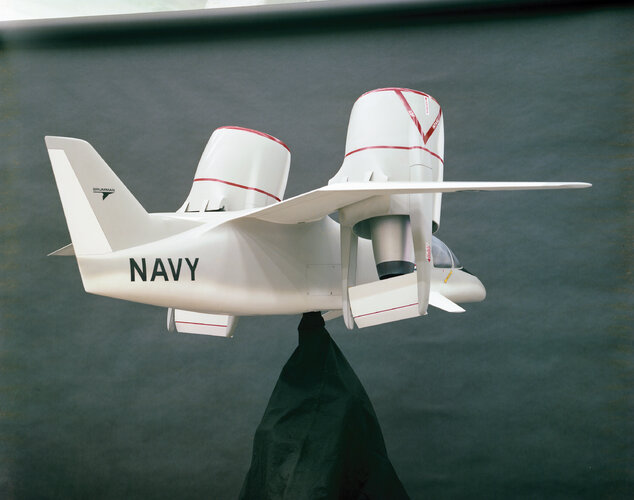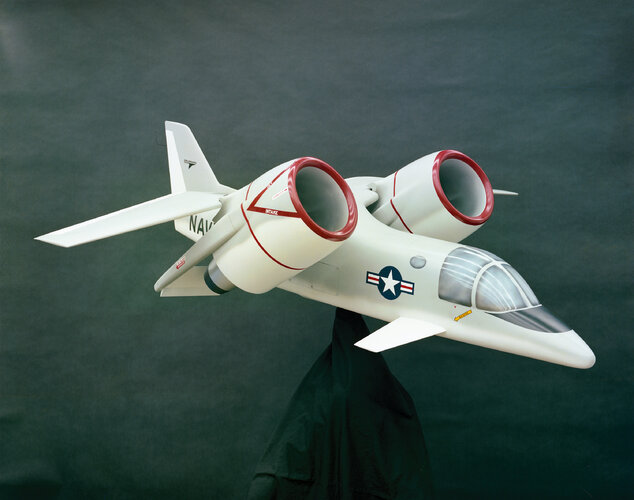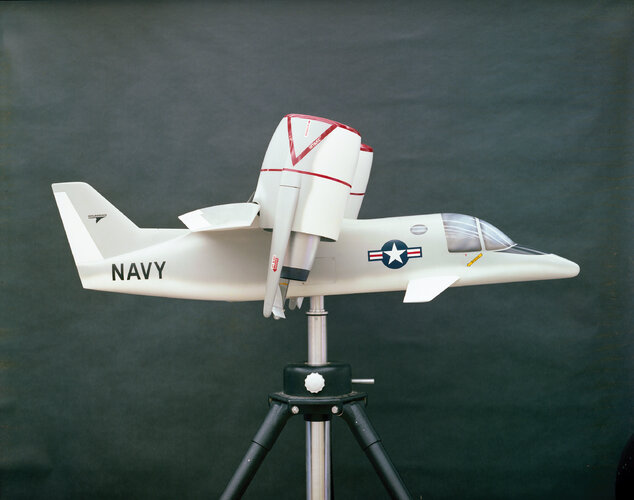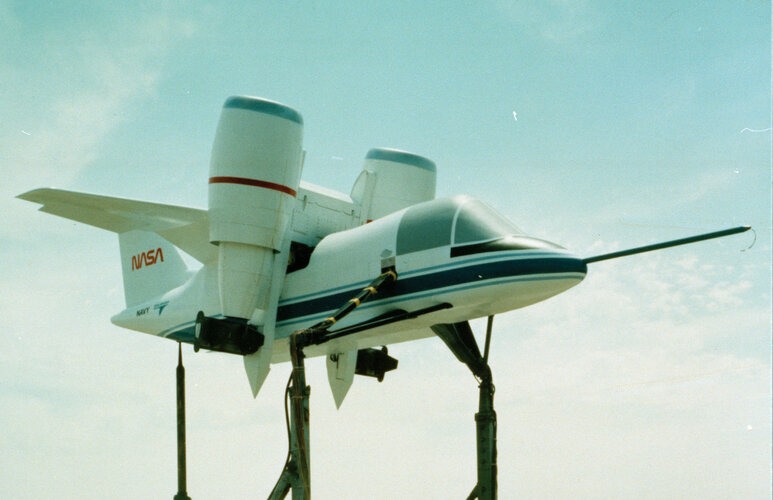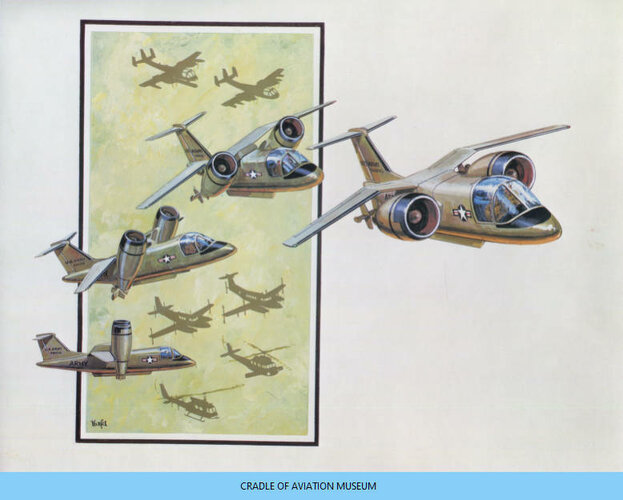You are using an out of date browser. It may not display this or other websites correctly.
You should upgrade or use an alternative browser.
You should upgrade or use an alternative browser.
Grumman G-698 V/STOL (US Navy "Type A" proposal)
- Joined
- 27 December 2005
- Messages
- 17,734
- Reaction score
- 26,296
Omphaloskepsis : contemplation of one's navel as an aid to meditation.
Heh.
Heh.
Brickmuppet
ACCESS: Secret
A couple of people have asked why this design failed.
I have no idea if ithe failure was technical or political.
However, looking at that first picture in the thread with the parachute inexplicably not getting sucked into the turbofan and air rescue being conductd next to the jet blast...
...well, I can imagine a scenario where someone looked at the concept art and decided that this was either unserious or the engineers were smoking crack.
I have no idea if ithe failure was technical or political.
However, looking at that first picture in the thread with the parachute inexplicably not getting sucked into the turbofan and air rescue being conductd next to the jet blast...
...well, I can imagine a scenario where someone looked at the concept art and decided that this was either unserious or the engineers were smoking crack.
Attachments
- Joined
- 31 May 2009
- Messages
- 1,154
- Reaction score
- 671
Grumman put a lot of its own money into developing the 698, which was well on its way to becoming a real airplane. As the story goes, some Grumman executives and project managers witnessed the spectacularly polished performance of the Bell XV-15 at the 1981 Paris Air Show and subsequently recommended winding down the Model 698 program.
Not sure about this story's accuracy, but Bell Aerospace engineers like to think this is how it happened.
Not sure about this story's accuracy, but Bell Aerospace engineers like to think this is how it happened.
- Joined
- 18 March 2008
- Messages
- 3,529
- Reaction score
- 976
Brickmuppet said:However, looking at that first picture in the thread with the parachute inexplicably not getting sucked into the turbofan and air rescue being conductd next to the jet blast...
It’s called lateral separation. In the picture the perspective of the artist point of view may make them look close together but they are well separated and as the air vehicle is moving forwards the parachute will fly to the rear. The only way it would get sucked into the intake is if the interception was made in the hover with a strong side wind. Which would clearly not be the way to do it. The jet blast as well would not be much of a problem as the recovery wire from hook to door looks like it diverts around it.
Brickmuppet said:...well, I can imagine a scenario where someone looked at the concept art and decided that this was either unserious or the engineers were smoking crack.
I can imagine the scenario where the USAF rescue service requested this kind of capability from the aerospace industry. Based on the extensive and highly costly experience of CSAR in VietNam and the proven air recovery of drones and satellite packages. If only they could pluck airman out of the air before they hit the ground they could save large numbers of shot down aircrew and avoid the huge risk and expense of a rescue mission.
My take on VSTOL A is that when it became apparent that the none of the lift fans could do the missions with existing technology, the Navy decided to focus on VSTOL B instead. Grumman went as far with the G-698 with their own money as they could. When Navy or NASA funding wasn't forthcoming to take the program to the next level, Grumman stopped work on it.
SlickDriver
ACCESS: Confidential
- Joined
- 20 June 2006
- Messages
- 161
- Reaction score
- 35
In this time period - I was in Flight School at Fort Rucker and large number of of viable projects were cancelled wholesale including the B-1A which had already flown.
This was a time period of huge defense cuts especially in new projects. I can't say for certainty that this was the case on this particular project, but it is highly likely that was the case.
This was a time period of huge defense cuts especially in new projects. I can't say for certainty that this was the case on this particular project, but it is highly likely that was the case.
- Joined
- 31 May 2009
- Messages
- 1,154
- Reaction score
- 671
A trade-show model from Grumman's in-house model shop, showing the final configuration of the G-698 proposal for the U.S. Marine Corps. Note large canards, refueling probe (from an A-6 Intruder), repositioned main wing and removal of the mechanical linkage between tilt engine nacelles. All of these modifications allowed for a larger and more practical internal payload clearance, along with rear loading doors.
Folding wings and vertical fin allowed tighter storage on aircraft carriers.
Folding wings and vertical fin allowed tighter storage on aircraft carriers.
Attachments
Kiltonge
Greetings Earthling
- Joined
- 24 January 2013
- Messages
- 631
- Reaction score
- 1,179
The Marine Corps assault version would have an aft-loading ramp and could accommodate 23 combat-equipped troops.
Also being studied is a vertical on-board delivery (VOD) model that would exceed the 45,0001b limit. That aircraft would require a
third top-mounted engine a la Boeing 727.
http://www.flightglobal.com/pdfarchive/view/1977/1977%20-%201312.html
- Joined
- 26 May 2006
- Messages
- 34,863
- Reaction score
- 15,727
Skyblazer said:Cool pic. Here it is enhanced and reversed, the way it should be:
Nice work my dear Skyblazer.
- Joined
- 26 May 2006
- Messages
- 34,863
- Reaction score
- 15,727
- Joined
- 26 May 2006
- Messages
- 34,863
- Reaction score
- 15,727
hesham said:Hi,
http://archive.aviationweek.com/search?exactphrase=true&QueryTerm=V%2FSTOL&start=160&rows=20&DocType=Image&Sort=&SortOrder=&startdate=1944-10-10&enddate=1990-09-08&LastViewIssueKey=&LastViewPage=
The concept is new for me.
Brickmuppet
ACCESS: Secret
I saw in another thread that this AEW version of plane was intended to not only direct AA missiles over the horizon, but to work as a "missileer". What missiles would it have used? Phoenix, Standard, or some variant of Sparrow?
- Joined
- 27 December 2005
- Messages
- 17,734
- Reaction score
- 26,296
Updated patent links.
- Joined
- 27 December 2005
- Messages
- 17,734
- Reaction score
- 26,296
Nice pics.
Firefinder
ACCESS: Top Secret
- Joined
- 5 October 2019
- Messages
- 1,041
- Reaction score
- 1,892
By apperantly having a Cross shaft to keep both side powered til the hard landing.How did this concept deal with an engine out in hover?
Other then that?
Imagine it be like a Chinnook Osprey with an Engine out, scary and you want to land now.
Scott Kenny
ACCESS: USAP
- Joined
- 15 May 2023
- Messages
- 11,531
- Reaction score
- 14,122
I can't imagine that it would have a lot of gross weight for Phoenix or Standards, not with a full load of radar and operators inside.I saw in another thread that this AEW version of plane was intended to not only direct AA missiles over the horizon, but to work as a "missileer". What missiles would it have used? Phoenix, Standard, or some variant of Sparrow?
- Joined
- 25 June 2009
- Messages
- 14,750
- Reaction score
- 6,113
Found at National Archives:
(original file: https://catalog.archives.gov/id/354361562)
(original file: https://catalog.archives.gov/id/354361562)
Attachments
- Joined
- 25 June 2009
- Messages
- 14,750
- Reaction score
- 6,113
Also this image of the test-rig model.
Original image: https://catalog.archives.gov/id/354345146
Original image: https://catalog.archives.gov/id/354345146
Attachments
- Joined
- 18 October 2006
- Messages
- 4,205
- Reaction score
- 4,894
I have not done the entire thread, so it may already have been pointed out that one reason the type likely did not make it further is that there was not a large enough customer base for it. Sure the USN would have had a fast VTOL, but what niche would it fill? Surely not ASW, as that requires long endurance efficient hovering. To small for COD. USMC wants VTOL that can operate from unprepared locations. US Army was (still is) devoutly rotary wing centric and USAF was not a fan of slow anything. Without big orders from prime customers I am not sure there would be foreign sales.
That said it might have found a niche as an EW platform for the USMC/USN to support their assault operations and , but I am not sure it would have warranted the cost.
Too bad a really cool platform.
That said it might have found a niche as an EW platform for the USMC/USN to support their assault operations and , but I am not sure it would have warranted the cost.
Too bad a really cool platform.
- Joined
- 4 July 2010
- Messages
- 2,513
- Reaction score
- 3,090
Think of the production version as a VTOL S-3 Viking.I have not done the entire thread, so it may already have been pointed out that one reason the type likely did not make it further is that there was not a large enough customer base for it. Sure the USN would have had a fast VTOL, but what niche would it fill? Surely not ASW, as that requires long endurance efficient hovering. To small for COD. USMC wants VTOL that can operate from unprepared locations. US Army was (still is) devoutly rotary wing centric and USAF was not a fan of slow anything. Without big orders from prime customers I am not sure there would be foreign sales.
That said it might have found a niche as an EW platform for the USMC/USN to support their assault operations and , but I am not sure it would have warranted the cost.
Too bad a really cool platform.
- Joined
- 25 June 2009
- Messages
- 14,750
- Reaction score
- 6,113
Forgot to specify that this was a proposal for the Army's SEMA-X program.The G-698 in U.S. Army guise:
Here is what I found on SEMA-X in the Feb.-Mar. 1982 issue of Army Aviation:
There is also an entire article on SEMA and SEMA-X, which I'm attaching here.Presently there are 10 different Army airborne Intelligence/Electronic Warfare (lEW) platforms, most of which are modified civilian fixed-wing aircraft. The SEMA-X is intended to replace the OV-1, RV-1, RU-21, and RC-12 aircraft in the 1990's. SEMA-X's primary role will be to gather batlefield intelligence for use in directing activities along the Forward Line of Troops (FLOT) and will also perform areconnaissance/early warning role. The UH-60A, AH-64A, and CH-47D P3I programs will enhance ASE and avionics standardization.
Attachments
Similar threads
-
US Navy "V/STOL Type A" competition
- Started by flateric
- Replies: 55
-
REQUIREMENT: US Navy VFA - V/STOL Fighters for Sea Control Ships
- Started by overscan (PaulMM)
- Replies: 5
-
Advanced Tactical Support Aircraft (ATSA) US Navy
- Started by dauby09
- Replies: 22
-
David W. Taylor Naval Ship Research and Development Center Aircraft Designs
- Started by hesham
- Replies: 11
-

















